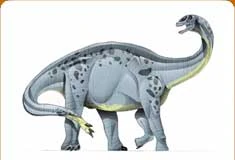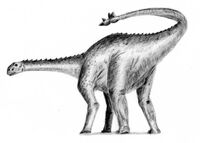
Shunosaurus, meaning "Shu Lizard", is a genus of sauropod dinosaur from Middle Jurassic (Bathonian–Callovian) beds in Sichuan Province in China, 170 million years ago. The name derives from "Shu", an ancient name for the Sichuan province.
Discovery and species[]
The first fossil of Shunosaurus was discovered in 1977 by a group of students, practising paleontological excavation at a road bank. The type species, Shunosaurus lii, was described and named by Dong Zhiming, Zhou Shiwu and Zhang Yihong in 1983. The generic name derives from "Shu", an ancient name for Sichuan. The specific name honours hydrologist Li Bing, the governor of Sichuan in the third century BC.[1]
The holotype, IVPP V.9065, was collected from the Lower Xiashaximiao Formation near Dashanpu, Zigong. It consists of a partial skeleton. Later about twenty more major specimens were discovered, including several complete or near-complete skeletons, skulls and juveniles, making Shunosaurus one of the best anatomically known sauropods, with 94% of all skeletal elements identified. Shunosaurus skeletons are on display at the Zigong Dinosaur Museum in Zigong, Sichuan Province, and the Beijing Museum of Natural History.
A second species, S. ziliujingensis, a name mentioned in the Zigong museum guide to indicate a smaller and older form, has never been formally described, and thus remains a nomen nudum.
Description[]
Shunosaurus was first estimated to be 11 metres (36 ft) long; later and more complete finds indicated a somewhat smaller size. In 2010 Gregory S. Paul estimated the length at 9.5 metres (31 ft), the weight at 3 metric tons (3.3 short tons).[2] Shunosaurus was very short-necked for a sauropod, being only "surpassed" in this respect by Brachytrachelopan.[3] The skulls found are mostly compressed or disarticulated and the interpretation of the head form has varied from broad, short and deep[4] to extremely narrow and pointed.[5] The upper and lower jaws were strongly curved upwards, allowing them to function as a pair of garden shears. The teeth were fairly robust but elongated with a crown length of up to 8 centimetres (3.1 in). They show a unique combination of a cylindrical body ending in a spatulate tip. In 1989 it was disclosed that the tail ended in a club,[6] equipped on its top with two successive spikes formed by 5 centimetres (2.0 in)-long cone-shaped osteoderms probably used to fend off enemies.
